Abstract
Mutant p53 is frequently detected in endometrial and ovarian carcinoma, but it is rare in cervical cancers. Previous reports focused on cervical squamous cell carcinoma, whereas cervical adenocarcinoma was given little attention. We searched for p53 gene mutations in 74 primary cervical adenocarcinomas with known human papillomavirus (HPV) status. Our aim was to evaluate the prevalence of p53 mutations and to investigate their possible role as an independent prognostic factor. We found mutations in 13.5% with a high rate of G:C --> A:T transitions as observed in endometrial adenocarcinoma. As p53 mutations are more frequently detected in malignancies of high grade, high stage, and large size, this molecular event seems to play a role in the progression rather than in the induction of cervical adenocarcinoma. In our series, patients with HPV-negative tumors and patients with mutated neoplasms, irrespective of HPV infection, had a shorter survival. Yet the absence of HPV infection and presence of p53 mutations are not independent risk factors for tumor-related death after adjustment for clinicopathological confounders. The only significant and independent predictors of survival are age of patient, stage of disease, tumor grade, and presence of lymph node metastases.
Full text
PDF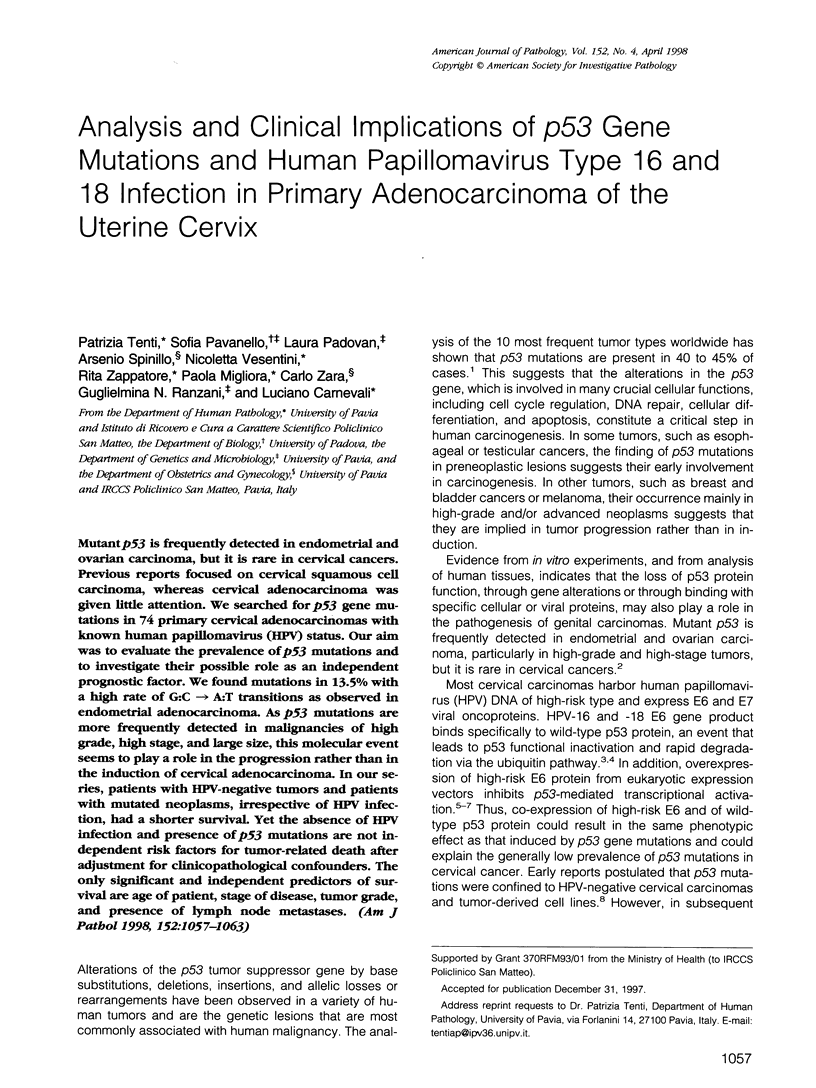

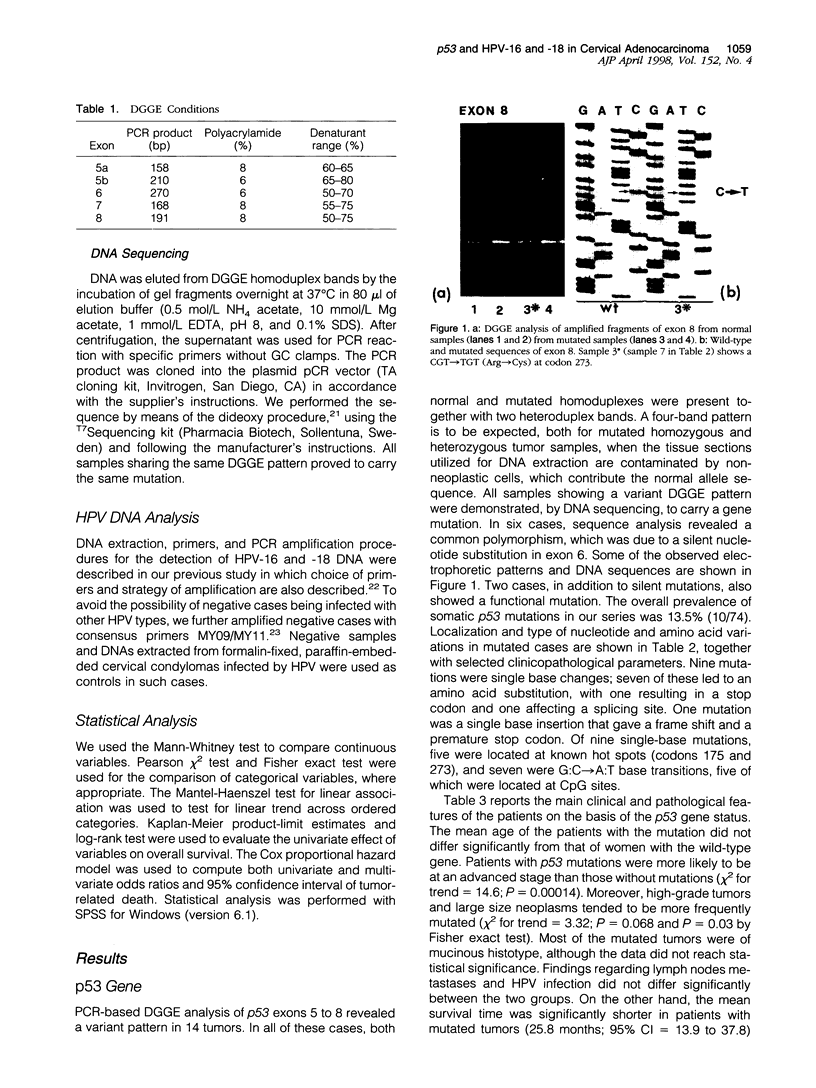
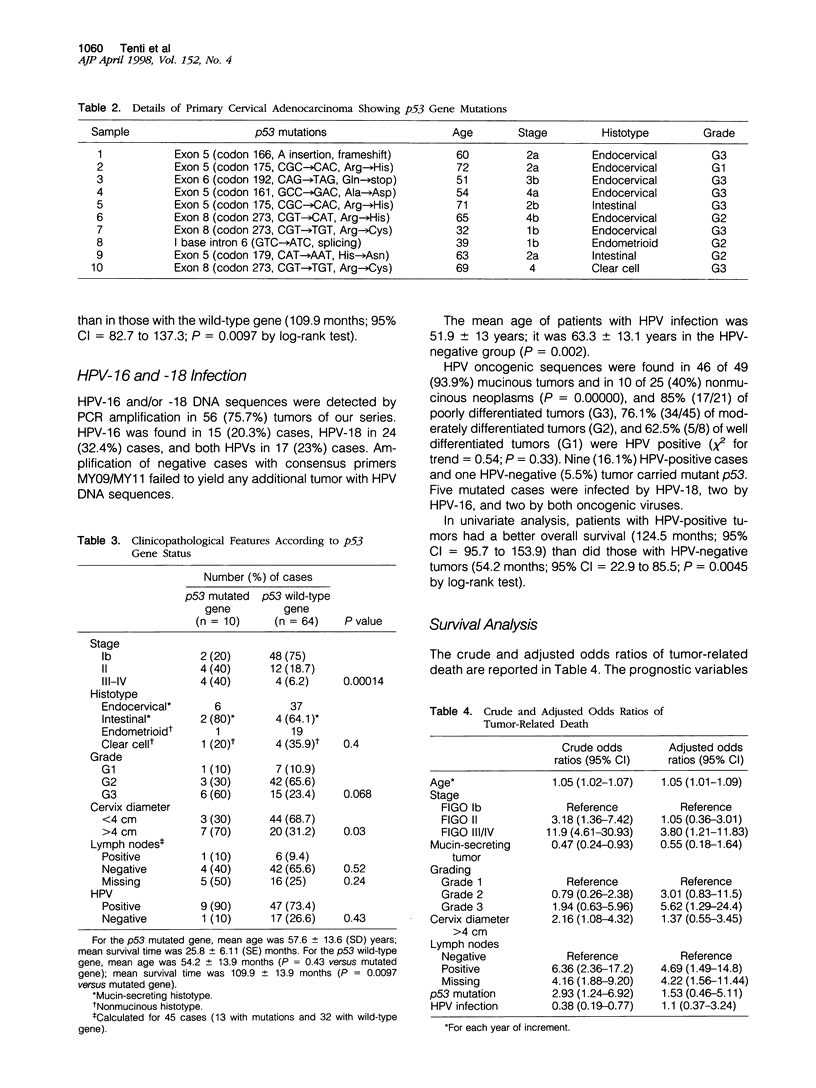
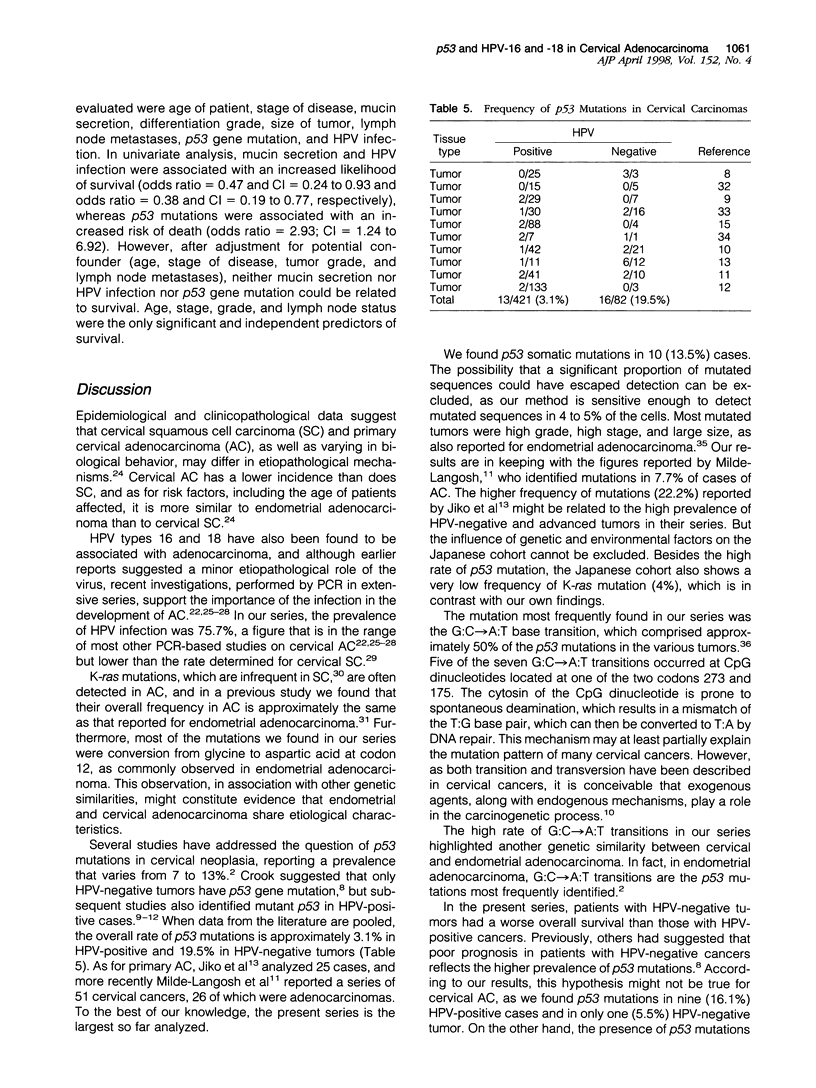
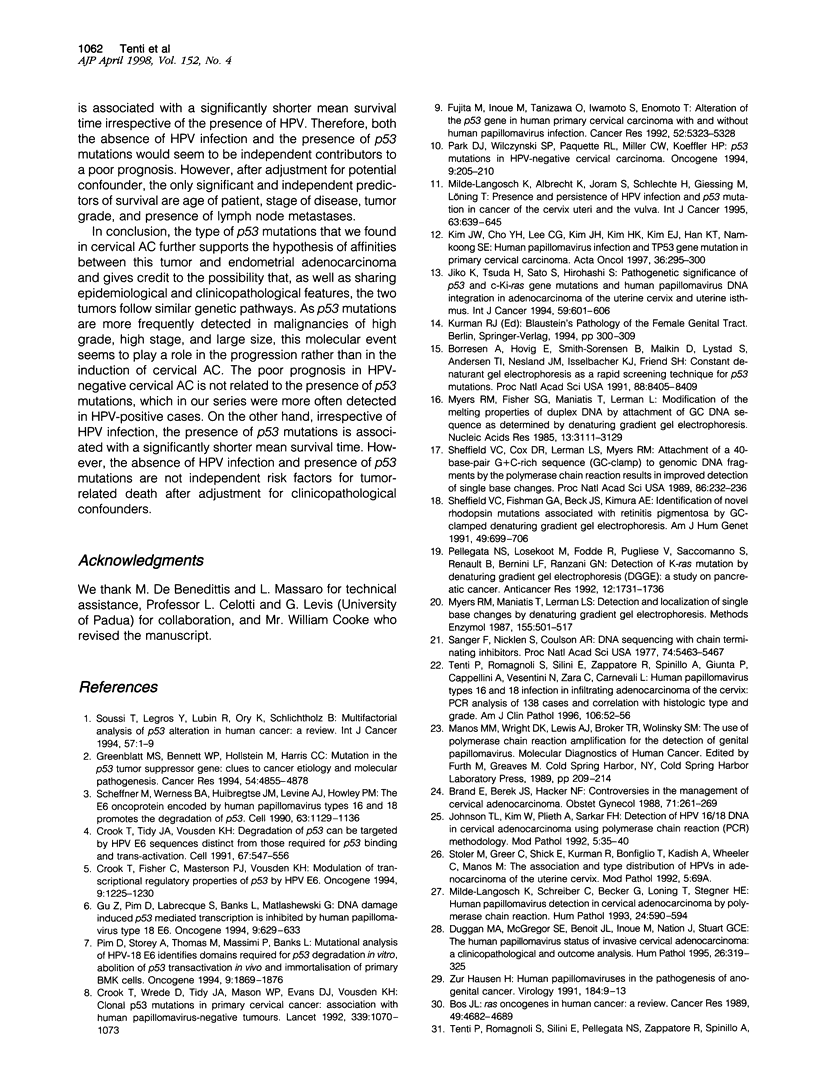

Images in this article
Selected References
These references are in PubMed. This may not be the complete list of references from this article.
- Bos J. L. ras oncogenes in human cancer: a review. Cancer Res. 1989 Sep 1;49(17):4682–4689. [PubMed] [Google Scholar]
- Brand E., Berek J. S., Hacker N. F. Controversies in the management of cervical adenocarcinoma. Obstet Gynecol. 1988 Feb;71(2):261–269. [PubMed] [Google Scholar]
- Busby-Earle R. M., Steel C. M., Williams A. R., Cohen B., Bird C. C. Papillomaviruses, p53, and cervical cancer. Lancet. 1992 May 30;339(8805):1350–1350. [PubMed] [Google Scholar]
- Børresen A. L., Hovig E., Smith-Sørensen B., Malkin D., Lystad S., Andersen T. I., Nesland J. M., Isselbacher K. J., Friend S. H. Constant denaturant gel electrophoresis as a rapid screening technique for p53 mutations. Proc Natl Acad Sci U S A. 1991 Oct 1;88(19):8405–8409. doi: 10.1073/pnas.88.19.8405. [DOI] [PMC free article] [PubMed] [Google Scholar]
- Crook T., Fisher C., Masterson P. J., Vousden K. H. Modulation of transcriptional regulatory properties of p53 by HPV E6. Oncogene. 1994 Apr;9(4):1225–1230. [PubMed] [Google Scholar]
- Crook T., Tidy J. A., Vousden K. H. Degradation of p53 can be targeted by HPV E6 sequences distinct from those required for p53 binding and trans-activation. Cell. 1991 Nov 1;67(3):547–556. doi: 10.1016/0092-8674(91)90529-8. [DOI] [PubMed] [Google Scholar]
- Crook T., Vousden K. H. Properties of p53 mutations detected in primary and secondary cervical cancers suggest mechanisms of metastasis and involvement of environmental carcinogens. EMBO J. 1992 Nov;11(11):3935–3940. doi: 10.1002/j.1460-2075.1992.tb05487.x. [DOI] [PMC free article] [PubMed] [Google Scholar]
- Crook T., Wrede D., Tidy J. A., Mason W. P., Evans D. J., Vousden K. H. Clonal p53 mutation in primary cervical cancer: association with human-papillomavirus-negative tumours. Lancet. 1992 May 2;339(8801):1070–1073. doi: 10.1016/0140-6736(92)90662-m. [DOI] [PubMed] [Google Scholar]
- Duggan M. A., McGregor S. E., Benoit J. L., Inoue M., Nation J. G., Stuart G. C. The human papillomavirus status of invasive cervical adenocarcinoma: a clinicopathological and outcome analysis. Hum Pathol. 1995 Mar;26(3):319–325. doi: 10.1016/0046-8177(95)90065-9. [DOI] [PubMed] [Google Scholar]
- Fujita M., Inoue M., Tanizawa O., Iwamoto S., Enomoto T. Alterations of the p53 gene in human primary cervical carcinoma with and without human papillomavirus infection. Cancer Res. 1992 Oct 1;52(19):5323–5328. [PubMed] [Google Scholar]
- Greenblatt M. S., Bennett W. P., Hollstein M., Harris C. C. Mutations in the p53 tumor suppressor gene: clues to cancer etiology and molecular pathogenesis. Cancer Res. 1994 Sep 15;54(18):4855–4878. [PubMed] [Google Scholar]
- Gu Z., Pim D., Labrecque S., Banks L., Matlashewski G. DNA damage induced p53 mediated transcription is inhibited by human papillomavirus type 18 E6. Oncogene. 1994 Feb;9(2):629–633. [PubMed] [Google Scholar]
- Hollstein M., Sidransky D., Vogelstein B., Harris C. C. p53 mutations in human cancers. Science. 1991 Jul 5;253(5015):49–53. doi: 10.1126/science.1905840. [DOI] [PubMed] [Google Scholar]
- Jiko K., Tsuda H., Sato S., Hirohashi S. Pathogenetic significance of p53 and c-Ki-ras gene mutations and human papillomavirus DNA integration in adenocarcinoma of the uterine cervix and uterine isthmus. Int J Cancer. 1994 Dec 1;59(5):601–606. doi: 10.1002/ijc.2910590505. [DOI] [PubMed] [Google Scholar]
- Johnson T. L., Kim W., Plieth D. A., Sarkar F. H. Detection of HPV 16/18 DNA in cervical adenocarcinoma using polymerase chain reaction (PCR) methodology. Mod Pathol. 1992 Jan;5(1):35–40. [PubMed] [Google Scholar]
- Kim J. W., Cho Y. H., Lee C. G., Kim J. H., Kim H. K., Kim E. J., Han K. T., Namkoong S. E. Human papillomavirus infection and TP53 gene mutation in primary cervical carcinoma. Acta Oncol. 1997;36(3):295–300. doi: 10.3109/02841869709001266. [DOI] [PubMed] [Google Scholar]
- Milde-Langosch K., Albrecht K., Joram S., Schlechte H., Giessing M., Löning T. Presence and persistence of HPV infection and p53 mutation in cancer of the cervix uteri and the vulva. Int J Cancer. 1995 Nov 27;63(5):639–645. doi: 10.1002/ijc.2910630507. [DOI] [PubMed] [Google Scholar]
- Milde-Langosch K., Schreiber C., Becker G., Löning T., Stegner H. E. Human papillomavirus detection in cervical adenocarcinoma by polymerase chain reaction. Hum Pathol. 1993 Jun;24(6):590–594. doi: 10.1016/0046-8177(93)90237-b. [DOI] [PubMed] [Google Scholar]
- Myers R. M., Fischer S. G., Maniatis T., Lerman L. S. Modification of the melting properties of duplex DNA by attachment of a GC-rich DNA sequence as determined by denaturing gradient gel electrophoresis. Nucleic Acids Res. 1985 May 10;13(9):3111–3129. doi: 10.1093/nar/13.9.3111. [DOI] [PMC free article] [PubMed] [Google Scholar]
- Myers R. M., Maniatis T., Lerman L. S. Detection and localization of single base changes by denaturing gradient gel electrophoresis. Methods Enzymol. 1987;155:501–527. doi: 10.1016/0076-6879(87)55033-9. [DOI] [PubMed] [Google Scholar]
- Park D. J., Wilczynski S. P., Paquette R. L., Miller C. W., Koeffler H. P. p53 mutations in HPV-negative cervical carcinoma. Oncogene. 1994 Jan;9(1):205–210. [PubMed] [Google Scholar]
- Pellegata N. S., Losekoot M., Fodde R., Pugliese V., Saccomanno S., Renault B., Bernini L. F., Ranzani G. N. Detection of K-ras mutations by denaturing gradient gel electrophoresis (DGGE): a study on pancreatic cancer. Anticancer Res. 1992 Sep-Oct;12(5):1731–1735. [PubMed] [Google Scholar]
- Pim D., Storey A., Thomas M., Massimi P., Banks L. Mutational analysis of HPV-18 E6 identifies domains required for p53 degradation in vitro, abolition of p53 transactivation in vivo and immortalisation of primary BMK cells. Oncogene. 1994 Jul;9(7):1869–1876. [PubMed] [Google Scholar]
- Sanger F., Nicklen S., Coulson A. R. DNA sequencing with chain-terminating inhibitors. Proc Natl Acad Sci U S A. 1977 Dec;74(12):5463–5467. doi: 10.1073/pnas.74.12.5463. [DOI] [PMC free article] [PubMed] [Google Scholar]
- Scheffner M., Werness B. A., Huibregtse J. M., Levine A. J., Howley P. M. The E6 oncoprotein encoded by human papillomavirus types 16 and 18 promotes the degradation of p53. Cell. 1990 Dec 21;63(6):1129–1136. doi: 10.1016/0092-8674(90)90409-8. [DOI] [PubMed] [Google Scholar]
- Sheffield V. C., Cox D. R., Lerman L. S., Myers R. M. Attachment of a 40-base-pair G + C-rich sequence (GC-clamp) to genomic DNA fragments by the polymerase chain reaction results in improved detection of single-base changes. Proc Natl Acad Sci U S A. 1989 Jan;86(1):232–236. doi: 10.1073/pnas.86.1.232. [DOI] [PMC free article] [PubMed] [Google Scholar]
- Sheffield V. C., Fishman G. A., Beck J. S., Kimura A. E., Stone E. M. Identification of novel rhodopsin mutations associated with retinitis pigmentosa by GC-clamped denaturing gradient gel electrophoresis. Am J Hum Genet. 1991 Oct;49(4):699–706. [PMC free article] [PubMed] [Google Scholar]
- Sherman M. E., Bur M. E., Kurman R. J. p53 in endometrial cancer and its putative precursors: evidence for diverse pathways of tumorigenesis. Hum Pathol. 1995 Nov;26(11):1268–1274. doi: 10.1016/0046-8177(95)90204-x. [DOI] [PubMed] [Google Scholar]
- Soussi T., Legros Y., Lubin R., Ory K., Schlichtholz B. Multifactorial analysis of p53 alteration in human cancer: a review. Int J Cancer. 1994 Apr 1;57(1):1–9. doi: 10.1002/ijc.2910570102. [DOI] [PubMed] [Google Scholar]
- Tenti P., Romagnoli S., Silini E., Pellegata N. S., Zappatore R., Spinillo A., Zara C., Ranzani G. N., Carnevali L. Analysis and clinical implications of K-ras gene mutations and infection with human papillomavirus types 16 and 18 in primary adenocarcinoma of the uterine cervix. Int J Cancer. 1995 Feb 20;64(1):9–13. doi: 10.1002/ijc.2910640104. [DOI] [PubMed] [Google Scholar]
- Tenti P., Romagnoli S., Silini E., Zappatore R., Spinillo A., Giunta P., Cappellini A., Vesentini N., Zara C., Carnevali L. Human papillomavirus types 16 and 18 infection in infiltrating adenocarcinoma of the cervix: PCR analysis of 138 cases and correlation with histologic type and grade. Am J Clin Pathol. 1996 Jul;106(1):52–56. doi: 10.1093/ajcp/106.1.52. [DOI] [PubMed] [Google Scholar]
- Tsuda H., Hirohashi S. Frequent occurrence of p53 gene mutations in uterine cancers at advanced clinical stage and with aggressive histological phenotypes. Jpn J Cancer Res. 1992 Nov;83(11):1184–1191. doi: 10.1111/j.1349-7006.1992.tb02743.x. [DOI] [PMC free article] [PubMed] [Google Scholar]
- zur Hausen H. Human papillomaviruses in the pathogenesis of anogenital cancer. Virology. 1991 Sep;184(1):9–13. doi: 10.1016/0042-6822(91)90816-t. [DOI] [PubMed] [Google Scholar]



